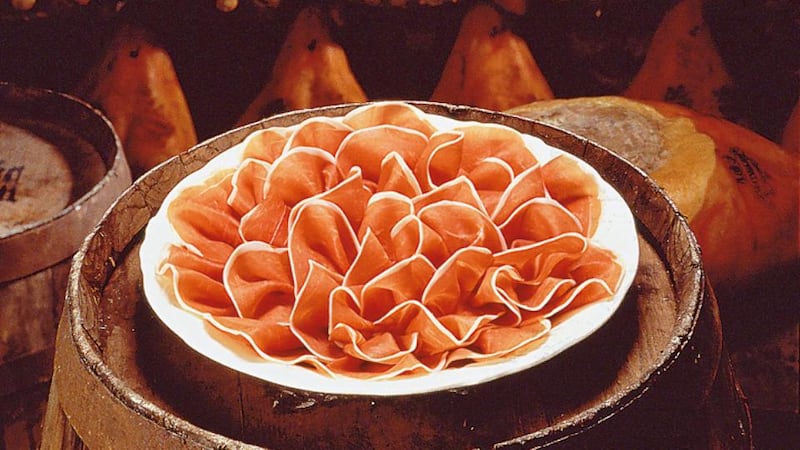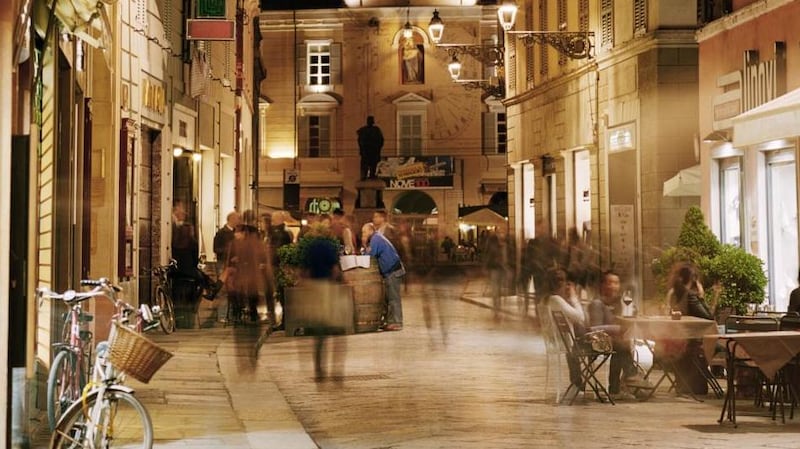If Parmesan is the king of cheeses, then Parma ham is the J-Lo of the porcine world, each plump buttock selected for its perfect pear shape and fat-to-lean meat ratio. To wrap a nugget of crumbly, slightly grainy, aged Parmesan in the sweet, palest pink folds of a slice of this special ham and then dip the parcel in a puddle of balsamic vinegar is to indulge in what the Italians call the “holy trinity”.
These three PDO or Protected Designation of Origin products, cornerstones of Italian cooking, are all produced in Emilia-Romagna, and to enjoy them at their best, the prosperous and pretty city of Parma, an hour’s drive northwest of Bologna, is a good place to start.
This is a city that celebrates its food traditions as proudly as it does its academic and cultural achievements. It may have one of the oldest universities in the world, claim Guiseppe Verdi as its favourite son, and boast a cathedral with a magnificent frescoed dome by Correggio, but in Parma, good food is also revered. The city’s 50th Prosciutto di Parma festival last September was celebrated just as enthusiastically as the Verdi festival the following month.


For centuries the hills surrounding the city, caressed by salty sea breezes scented with pine, have been a centre for the production of cured pork. The dry, cool conditions are ideal for ageing cured meats without spoilage. There are now 161 ham factories in Parma, producing just over nine million of those plump legs each year – 75 per cent of which are consumed in Italy.
Parma ham can only be made with one of three varieties of pig – Large White, Landrace and Duroc – reared in accordance with strict guidelines governing location, animal husbandry and diet, which must include whey, a byproduct in the production of Parmesan. They can be farmed in any of 10 regions in central northern Italy, but to be transformed into Parma ham they must be processed in a tightly controlled geographic zone at least 5km outside the city, up to a height of 900m, within strict boundaries.
Elena Dalla Bona is general manager of the Eli Prosciutti factory at Traversetolo. Her family-owned business produces 60,000 legs of Parma ham a year, in a skilful process that involves salting, resting, washing, pre-curing, greasing, curing – and finally, after a minimum of 12 months, branding with the distinctive Ducal Crown that is the symbol of the Parma Ham Consortium and a guarantee of quality and authenticity.
The process is completely natural and throughout the maturation process each of the hams is regularly tested by experts, who piece them in five places with a horse bone needle and use their finely tuned olfactory skills to detect any possible deterioration. Good Parma ham should have white fat, not yellow or cream, and smell sweet and fragrant.
The legs are generally sold at 15/16 months, but can be matured up to 24 months. Some 9,000 whole legs of Parma ham are imported into Ireland each year, but by far the biggest market is in pre-sliced packs which accounts for 70 per cent of the export market. The slicing is done in Italy, to ensure strict quality controls are adhered to, and breaches have resulted in court actions, notably a successful European Court of Justice case against the UK multiple Asda.
Despite the early hour of our visit to Eli Prosciutti, Dalla Bona insists on popping open a bottle of dry sparkling wine as we assemble in her office to taste her ham. The wine will cleanse the palate of fat, she insists. And eating the fat is intrinsic to the experience, the pure white ruffles edging the pallet, rose pink flesh. This is ham like none I have eaten before, sweet and salty, as you’d expect, but delicate and refined too. The bread we eat it with is unsalted, to provide the best foil for the ham.
The following morning, we have an early start at the Co-Op Spaccio to see raw cow’s milk being made into Parmesan cheese in a process that has changed little in the past eight centuries. Skimmed milk (the cream goes to make butter), from the evening milking is added to the morning’s fresh full-fat milk in giant copper vats, each with a capacity of 1,200 litres which will in turn yield two wheels of Parmesan. The milk is heated to 36 degrees and whey and rennet are added – in quantities decided by the master cheesemaker, a skilled profession in Italy that can command a salary of in the region of €100,000. Cheese is made 365 days a year, so the salary is well earned.
Steam rises in the dairy as the cheesemakers use a giant balloon whisk, called spino, to break up the warm curds as they cook in the vats. Once the cheesemaker is happy with the consistency, the whey is drained and the cheese is expertly divided into two “twins” and skilfully tossed, using giant muslin cloths, into waiting willow-frame baskets, where it will “rest” for two to three days.
Less than an hour after receiving the morning milk, the dairy has made cheese, but it’s not yet Parmesan. For it to become Parmesan, it must spend 18-20 days submerged in a sea-salt brine, and then be aged for a minimum of 12 months. The best quality wheels will undergo further ageing, in warehouses where they are turned and brushed every four days, by machine, with some being aged to 36 months, or more.
Igino Morini from the Parmigiano Reggiano Consortium shows us how the wheels are tapped with a small metal hammer and the sounds used to assess how they are developing. Every cheese is inspected in this manner by the consortium at 12 months. Those that don’t make the grade to warrant further ageing are sold as “Mezzano”, and are meant to be eaten young.
Morini says he “feels emotional” as a three-year-old wheel, branded with the date February 2010 is selected for us. The saying that “you don’t cut Parmigiano Reggiano, you open it like a jewel case”, rings true as the giant 35kg wheel is cut around its equator with surgical precision, incised and finally prised open in front of us to reveal its craggy, granular interior.
We taste this venerable old cheese in comparison with 12- and 24-month matured varieties, and the differences are marked. The young cheese is soft and creamy, with a clean, sweet flavour, reminiscent of butter and yoghurt. The older cheeses are more complex in taste and the structure becomes more granular with age as the amount of white, crunchy speckles, created by an amino acid called tyrosine, increases.
Most dairies have farm shops where you can buy Parmesan at various stages of maturation, at very good prices. And we leave with bags stuffed with vac-packed giant wedges that will in coming weeks and months be grated over steaming bowls of pasta, shaved over winter salads, and broken into chunks to be nibbled as both pre- and post-dinner treats.
I’ve always loved Parmesan and Parma ham, but after seeing how they’re produced, I leave Parma with a new appreciation of their unique and time-honoured qualities. You can book a free tour of a Parmesan dairy at parmigianoreggiano.com, but at least three weeks’ notice should be given. Several food-tour firms, such as parmagolosa.it, foodnwalktours.com and foodtours.it, offer customised Prosciutto, Balsamico and Parmigiano tours from Parma.
WHERE TO EAT IN PARMA
At Diego Sorba's Tabarro wine bar, you can accompany your local cured meat and cheese platters with a glass of "natural" wine, and a side order of literary discussion with the proprietor, a scholar of modern Irish poetry, who majored in the works of Louis MacNeice, and has worked at Sheridans in Galway. Don't miss his Piedemontese beef cured with honey.
Tabarro, Strada Farini 5b, Parma, tel: 00-39-0521-200233
At Ristorante Cocchi, we learned to taste the difference between Parmesan made with summer and winter milk, and tucked into giant plates of tagliolini, fragrant with black truffle. There was a well-known director of a cookery school in Milan eating nearby and we strained to see what the maestro ordered. Several plates in, we could only marvel at his appetite. Cocchi is a smart, tablecloth-and-crystal place, but reasonably priced.
Ristorante Cocchi, Via Gramsci 16/A, Parma, tel: 00-39-0521-995147
Ristorante Parizzi is a sleek, modern, Michelin-starred restaurant with rooms, in the centre of town. As well as the artful plates you’d expect at this level, such as the rosemary-roasted lobster with bitter orange sauce I enjoyed so much that I’d return to Parma just to eat it again, Parizzi also offers comparative tastings of different ages of Parma ham and Parmesan. Chef Marco Parizzi also runs a cookery school. Six-course tasting menus of land (€65) and sea (€70) are available.
Ristorante Parizzi, Strada della Repubblica, Parma,
tel: 00-39-0521-285952
Marie-Claire Digby travelled to Parma as a guest of Discover the Origin, a campaign financed with aid from the EU, Italy, France and Portugal to promote Bourgogne Wines, Parma Ham, Douro Wines, Parmigiano Reggiano and Port










